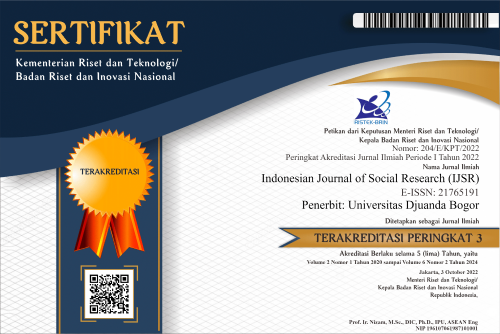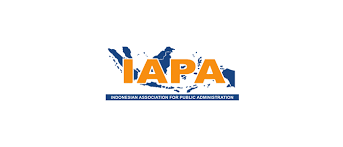Illegal Animal Trade by Crime Groups between Indonesia and Australia Becomes a Phenomenon that Threatens Global Issues
Abstract
This research explains the phenomenon of illegal animal trade, which is one of the organized transnational crimes in the current era of globalization. Australia and Indonesia are countries affected by the illegal animal trade, making it a global threat that cannot be overcome easily. The research question is why illegal animal trade between Australia and Indonesia has become a strong network at the international level and threatens a global issue. The aim of this research is to analyze one case of TOC, namely the illegal animal trade that occurred between Indonesia and Australia, because this issue is a phenomenon that threatens global issues and has become a strong network at the international level. Data was collected through various literature sources and literature studies, and document review techniques were used for the data collected in this research. Data analysis uses analysis with a descriptive and qualitative approach. The amount of literature used in this research was 12 journal articles, 8 newspapers and reports, five repositories, two theses, and three books. The results of the analysis found several findings and answers from this research, namely that this phenomenon involves two countries, apart from that this crime causes other crimes, and the perpetrators are part of an organized crime group that has many networks at the international level to carry out illegal animal trade on the international black market.
References
Antara News. (2009). Kebun Binatang Bali Jalin Kerjasama dengan Australia. Antara News. https://www.antaranews.com/berita/88/kebun-binatang-bali-jalin-kerjasama-dengan-australia
Arinta, N. (2019). PERDAGANGAN SATWA LIAR ILEGAL: DARI PASAR HINGGA GAWAI. https://www.wwf.id/id/blog/perdagangan-satwa-liar-ilegal-dari-pasar-hingga-gawai
Auliya, M., Altherr, S., Ariano-Sanchez, D., Baard, E. H., Brown, C., Brown, R. M., Cantu, J.-C., Gentile, G., Gildenhuys, P., & Henningheim, E. (2016). Trade in live reptiles, its impact on wild populations, and the role of the European market. Biological Conservation, 204, 103–119.
Australian Government. (2021). Hefty jail sentence for illegal export of reptiles. https://www.dcceew.gov.au/about/news/media-releases/hefty-jail-sentence-illegal-export-reptiles#:~:text=Each%20wildlife%20offence%20carries%20a,au%20or%2002%206274%201900.
Badan Pusat Statistik. (2018). Jumlah Satwa Terancam Punah (Ekor), 2015-2017. https://www.bps.go.id/id/statistics-table/2/MTI5NyMy/jumlah-satwa-terancam-punah.html
della Porta, D. (2020). Spreading protests: Changing paths of transnationalization of social movements. Alternate Routes: A Journal of Critical Social Research, 31(1).
Finckenauer, J. O. (2012). Mafia and organized crime: A beginner’s guide. Simon and Schuster.
Hanim, L., Chalim, M. A., & Hafidz, J. (2020). Pelaksanaan Perlindungan Satwa Liar Yang Dilindungi Menurut Hukum Indonesia Dan Hukum Internasional. 1(1), 161–168.
Homeland Security Investigations. (n.d.). HSI IS A VITAL U.S. ASSET IN COMBATING CRIMINAL ORGANIZATIONS ILLEGALLY EXPLOITING AMERICA’S TRAVEL, TRADE, FINANCIAL AND IMMIGRATION SYSTEMS. https://www.ice.gov/about-ice/homeland-security-investigations
Ilya, A., & Syahraki, S. (2020). Digital Governance: Inovasi dengan Etika dan Integritas.
Injaya, S. R. (2013). Kerjasama internasional Indonesia dan Jepang: Peran Jepangterhadap isu deforestasi di Indonesia dalam skema Asia Forest Partnership (AFP) periode 2008-2011.
Iqbal, M. (2023). Penegakan Hukum Terhadap Pelaku Tindak Pidana Kepemilikan Satwa Dilindungi Menurut UU No 5 Tahun 1990 Tentang Konservasi Sumber Daya Alam Hayati Dan Ekosistemnya (Studi Putusan No 242/Pid. B/LH/Pn. Bna).
Jensen, M. P., Limpus, C. J., Whiting, S. D., Guinea, M., Prince, R. I., Dethmers, K. E., Adnyana, I. B. W., Kennett, R., & FitzSimmons, N. N. (2013). Defining olive ridley turtle Lepidochelys olivacea management units in Australia and assessing the potential impact of mortality in ghost nets. Endangered Species Research, 21(3), 241–253.
Maher, J., & Wyatt, T. (2017). International trade in animals and animal parts. The Palgrave International Handbook of Animal Abuse Studies, 223–247.
Mangunjaya, F. M. (2006). Hidup harmonis dengan alam: Esai-esai pembangunan lingkungan, konservasi, dan keanekaragaman hayati Indonesia. Yayasan Pustaka Obor Indonesia.
Marwiyah, S. (2014). Model Pemolisian Masyarakat Sebagai Upaya Penanggulangan Pembalakan Hutan. MODEL PEMOLISIAN MASYARAKAT SEBAGAI UPAYA PENANGGULANGAN PEMBALAKAN HUTAN.
Massari, M. (2004). Transnational organized crime between myth and reality: The social construction of a threat. In Organised Crime and the Challenge to Democracy (pp. 50–62). Routledge.
Ministry of the Environment and Forestry. (2020). Tanggapan KLHK Saat Satwa Liar Banyak Dijadikan Konten Medsos. https://ppid.menlhk.go.id/berita/siaran-pers/5396/tanggapan-klhk-saat-
Ministry of the Environment and Forestry. (2023). GAKKUM KLHK UNGKAP KASUS PERDAGANGAN ILEGAL SATWA DILINDUNGI SECARA DARING DI MERAUKE – PAPUA SELATAN. https://gakkum.menlhk.go.id/infopublik/detail/580
Prasetio, D. D., & Suhito, L. A. (2022). Tinjauan Transnational Organized Crime (TOC) pada Kasus Penyelundupan 1 Ton Sabu dalam Kapal MV Sunrise Glory. Deviance Jurnal Kriminologi, 6(1), 30–46.
Puspitasari, D. E. (2022). Maraknya Perdagangan Satwa Langka Di Era Pandemi Covid-19 Di Indonesia. PAMALI: Pattimura Magister Law Review, 2(1), 1–16.
Raden Ariyo Wicaksono. (2023). Subur Perdagangan Satwa Ilegal di Marketplace. Betahita. https://betahita.id/news/detail/8392/subur-perdagangan-satwa-ilegal-di-marketplace.html?v=1679963034
Setiawan, M. R. (2020). ANALISIS YURIDIS PENJATUHAN HUKUMAN BAGI PELAKU PERBURUAN LIAR DI KAWASAN HUTAN TAMAN NASIONAL WAY KAMBAS.
Setyawan, A. D. (2024). Liability For Illegal Trade in Protected Non-Endemic Wildlife in Indonesia. Jurnal Indonesia Sosial Teknologi, 5(2), 632–643.
Strauss, A., & Corbin, J. (1998). Basics of qualitative research techniques.
Supardan, D. (2005). Pendidikan multibudaya. Bandung: PT. Imperial Bhakti Utama.
SUSANTI, K. (2024). Konservasi Lingkungan Pantai Cemara Kelurahan Pakis Kecamatan Banyuwangi Kabupaten Banyuwangi Tahun 2015-2020.
Syahrin, M. A., & Utomo, Y. S. (2019). Implementasi Penegakan Hukum Pencari Suaka dan Pengungsi di Indonesia Setelah Diberlakukannya Peraturan Presiden Nomor 125 Tahun 2016 tentang Penanganan Pengungsi dari Luar Negeri. Jurnal Ilmiah Kajian Keimigrasian, 2(2), 84.
Veronica, C. (2022). Tindak Pidana Satwa Langka Yang Diperjualbelikan Lewat Media Sosial Ditinjau Dari Undang-Undang Nomor 5 Tahun 1990 Tentang Konservasi Sumber Daya Alam Hayati Dan Ekosistemnya. LEX ADMINISTRATUM, 10(2).
Wyatt, T. (2021). Wildlife trafficking: A deconstruction of the crime, victims and offenders. Springer.
Yasin, M. (2023). Perancangan Buku Ilustrasi Petualangan Si Acho & Oba sebagai Media Pelestarian Hewan Endemik Papua dilengkapi dengan Augmented Reality.
Zakariya, R. (2021a). Penguatan Kerja Sama Lintas Negara dalam Penegakan Hukum Perdagangan Satwa Liar. Jurnal Hukum Lex Generalis, 2(11), 1039–1058.
Zulbahri, Z. (2019). Penegakan Hukum Terhadap Tindak Pidana Perdagangan Satwa Liar Dilindungi Oleh Balai Pengamanan Dan Penegakan Hukum Lingkungan Hidup Dan Kehutanan (BPPHLHK) Wilayah Sumatera.
Copyright (c) 2024 Indonesian Journal of Social Research (IJSR)

This work is licensed under a Creative Commons Attribution-ShareAlike 4.0 International License.
The Authors submitting a manuscript do so on the understanding that if accepted for publication, copyright publishing of the article shall be assigned/transferred to Indonesian Journal of Social Research (IJSR) Universitas Djuanda as Publisher of the journal. Upon acceptance of an article, authors will be asked to complete a 'Copyright Transfer Agreement'. An e-mail will be sent to the corresponding author confirming receipt of the manuscript together with a 'Copyright Transfer Agreement' form by online version of this agreement.
Indonesian Journal of Social Research (IJSR) Universitas Djuanda, the Editors and the Editorial Board make every effort to ensure that no wrong or misleading data, opinions or statements be published in the journal. In any way, the contents of the articles and advertisements published in the Indonesian Journal of Social Research (IJSR) Universitas Djuanda are sole and exclusive responsibility of their respective authors and advertisers.
Remember, even though we ask for a transfer of copyright, our journal authors retain (or are granted back) significant scholarly rights as mention before.
The Copyright Transfer Agreement (CTA) Form can be downloaded here: Copyright Transfer Agreement-IJSR 2020
The copyright form should be signed electronically and send to the Editorial Office e-mail below:
Dr. Rasmitadila, M.Pd (Editor-in-Chief)
Universitas Djuanda
Jl. Tol Jagorawi No.1, Ciawi, Kec. Ciawi, Bogor, Jawa Barat 16720
Website: http://journal.unida.ac.id/index.php/IJSR/index
Email: ijsr@unida.ac.id





4.png)



